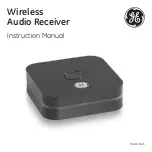
SWM7000-Quick-Guide-070525.pmd - rr
© Sabine 2007
Common Sources of RF Interference
It is best to keep the system’s channels close together at the low or high end of the spectrum, i.e. channels 1,
2,3,4,5 or channels 65, 66, 67, 68. If there is another 2.4 GHz source in the room, grouping the channels reduces the
chances of an overlap. Do not start by spreading your channels throughout the 70 channel range of the system - -you
are more likely to encounter interference this way.
Avoid potential sources of RF interference by performing a scan using Sabine’s Remote Control Software, which will
reveal the ambient RF level in your area on each channel of your system. Please refer to Section 13.4.2.5. for informa-
tion on the RF Scan function, which will automatically determine the best RF channels to use.
If you cannot perform a scan then proceed to use your system, beginning with Channel 1 and keep your chan-
nels grouped together. If you hear any RF “hits” or dropouts, then try another of the 70 available channels.
For best results, maintain line-of-sight from transmitter to receiver. Use either front or rear panel antenna mount-
ing to maintain line-of-sight. This is very important!
Mount receiver antennas at 90 degrees to one another, leaning away at 45 degree angles, in the same plane.
When using multiple receivers, try to maintain at least 1 foot (30 cm) distance between antennas from different
units. When such antenna spacing proves difficult or impossible, we recommend using Sabine’s SWA6SS An-
tenna Distribution Amplifier. The SWA6SS works with up to six receivers, or 12 channels.
Maximize the distance between the receiver and light sources, such as fluorescent bulbs or neon signs, which may
emit very short-range, broadband interference.
Maximize the distance between transmitters and receivers and potential sources of RF interference, as shown below.
Maintain a minimum distance of at least 3 meters (10 feet) between transmitters and receivers or extension
antennas. This can solve many anomalies.
Be careful not to set more than one transmitter to the same channel; each paired transmitter and receiver should
be set to unique corresponding channels, until all channels are receiving clearly and cleanly.
RF Performance Tips
4
To Extension Antennas
Antenna 1
RF Output 2
RF Output 1
Antenna 2
Antenna Distribution
Amplifier Connection
Connect receiver Antenna 1 input to any RF
Output 1 connector on the SWA6SS.
1
Antenna Distribution
Amplifier
Receiver
Connect any receiver Antenna 2 to
any RF Output 2 connector on the
SWA6SS.
2
Antenna Distribution
Amplifier
Receiver
Continue with remaining receivers.
3
Antenna Distribution
Amplifiers
SWM7000 Receivers
Microwave ovens Microwave ovens will likely present a problem only when located in fairly close proximity within
the same room as the wireless receiver (or reception antenna). See caution below.
Wireless Local Area Networks (WLANS) In general, Sabine microphones should not be affected by these
WLANS. Use the RF scanner included in Sabine because their spread spectrum technology does not present a
problem for the Sabine Smart Spectrum
TM
system. See caution below.
Cordless phones These home telephones broadcast at very low power and should not present interference
problems for your Sabine wireless. This is especially true if the telephone uses spread spectrum technology.
Wireless Video Cameras These devices are also very low power and, in general, should not present a problem
when using the SWM7000 system. See Section 5 Receiver Operation for methods of optimizing clear reception and
minimizing interference. See caution below.
As a general precaution, keep 2.4 GHz cordless telephones, microwave ovens, WLAN antennas and 2.4 GHz wireless
video camera transmitters twice the distance from your Sabine wireless microphone system antennas as that of your
Sabine 2.4 GHz transmitters.
Antenna Placement Caution






















